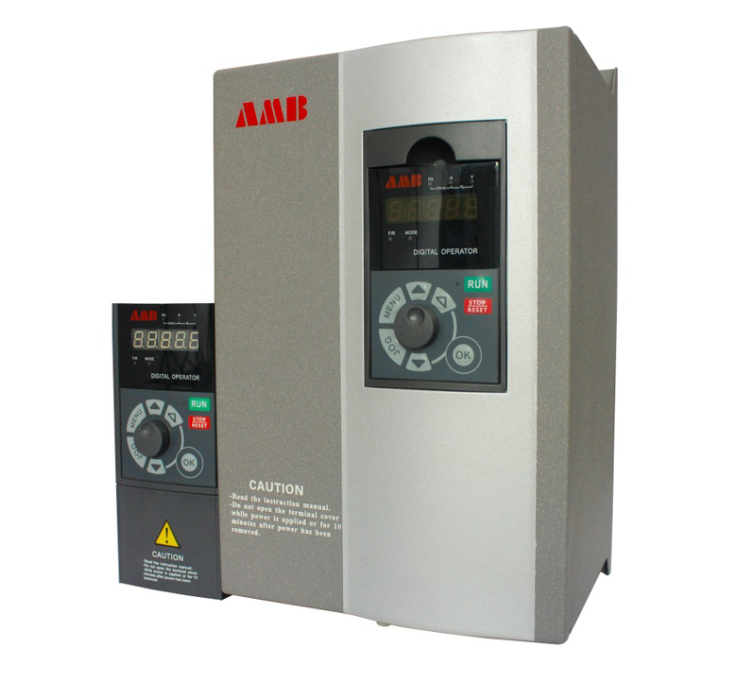
1. why can the rotation speed of the motor be changed freely?
Motor rotation speed unit: r/min rotation times per minute, or rpm
For example: 2 pole motor 50hz3000[r/min]
4 pole motor 50hz1500[r/min]
Conclusion: the rotating speed of motor is proportional to the frequency
The rotation speed of induction AC motor (hereafter referred to as motor) is approximately determined by the number of poles and frequency of the motor. The number of poles of the motor is fixed according to the working principle of the motor. Since the pole value is not a continuous value (a multiple of 2, for example, the number of poles is 2, 4, 6), it is generally uncomfortable and the motor speed is adjusted by changing the value.
In addition, the frequency can be adjusted outside the motor and then supplied to the motor, so that the motor rotation speed can be freely controlled.
Therefore, the inverter with the purpose of controlling frequency is the best equipment for motor speed regulation equipment.
n=60f/p
n: Synchronization speed
f: Power frequency
p: Motor pole number
Conclusion: changing frequency and voltage is the best method of motor control
If only the frequency is changed without changing the voltage, the frequency reduction will cause the motor to be out of overvoltage (overexcitation), which may cause the motor to be burnt out. Therefore, the frequency converter must change the voltage at the same time. When the output frequency is above the rated frequency, the voltage can not be increased continuously, and the maximum voltage can only be equal to the rated voltage of the motor.
For example, in order to reduce the rotation speed of the motor by half, the output frequency of the converter is changed from 50Hz to 25Hz, and the output voltage of the converter needs to be changed from 400V to about 200V
2. what is the output torque of the motor when the rotation speed (frequency) of the motor changes?
The starting torque and maximum torque of the inverter drive shall be less than that of the direct power frequency power supply
The motor starts and accelerates greatly when power supply is supplied by power supply, and when using frequency converter, these shocks will be weaker. Direct starting of power frequency will produce a large starting current. When using frequency converter, the output voltage and frequency of the inverter are gradually added to the motor, so the starting current and impact of the motor are smaller.
In general, the torque generated by the motor will decrease with the decrease of frequency (speed reduction). The actual data reduced will be explained in some frequency converter manuals.
By using flux vector control converter, the shortage of torque in low speed motor will be improved, and enough torque can be output even in low speed area.
3. When the frequency converter is adjusted to more than 50 Hz, the output torque of the motor will be reduced
The motor is usually designed and manufactured according to the voltage of 50 Hz, and its rated torque is also given in this voltage range. Therefore, the speed regulation under the rated frequency is called constant torque speed regulation. (t = te, P < = PE)
When the frequency converter output frequency is greater than 50 Hz frequency, the torque produced by the motor will decrease in a linear relationship inversely proportional to the frequency.
When the motor runs at the frequency of more than 50 Hz, the size of the motor load must be considered to prevent the insufficient output torque of the motor.
For example, the torque produced by a motor at 100Hz should be reduced to about half of the torque produced at 50Hz.
Therefore, the speed regulation above the rated frequency is called constant power speed regulation. (P = UE * IE)
4. Application of frequency converter above 50 Hz
As we all know, for a specific motor, its rated voltage and rated current are constant.
For example, the rated value of frequency converter and motor is 15kw / 380V / 30a, and the motor can work above 50 Hz.
When the speed is 50 Hz, the output voltage of the inverter is 380V and the current is 30A. At this time, if the output frequency is increased to 60Hz, the maximum output voltage and current of the inverter can only be 380V / 30A. Obviously, the output power remains unchanged, so we call it constant power speed regulation
What is the torque situation?
Because P = WT (W: angular velocity, t: torque). Because P is constant, w increases, so the torque decreases accordingly.
We can also look at it from another perspective
Stator voltage U = e + I * r (I is current, R is electronic resistance, e is induced potential)
It can be seen that when u and I are constant, e remains the same
And E = k * f * x, (K: constant, F: frequency, X: flux), so when f is from 50 to > 60Hz, x will decrease correspondingly
For the motor, t = k * I * x, (K: constant, I: current, X: flux), so the torque T decreases with the decrease of flux X
At the same time, when I * r is very small when I * r is less than 50 Hz, when u / F = E / F is constant, the flux (x) is constant. The torque T is proportional to the current. This is why the overload (torque) capacity of the inverter is usually described by the over-current capacity of the converter, which is also called constant torque speed regulation (constant rated current --- > maximum torque constant)
Conclusion: the output torque of the motor will decrease when the frequency of inverter increases from 50 Hz to above
5. Other factors related to output torque
The output current capacity of the inverter is determined by the heating and cooling capacity, which affects the output torque capacity of the inverter.
Carrier frequency: in general, the rated current marked by frequency converter is the value with the highest carrier frequency, which can ensure continuous output under the highest ambient temperature. When the carrier frequency is reduced, the motor current will not be affected. But the heating of components will be reduced.
Ambient temperature: as if not because of the detection of low ambient temperature on the inverter protection current value
Altitude: the increase of altitude will affect the heat dissipation and insulation performance. Generally, it is not considered if the altitude is below 1000m. It is OK to reduce the capacity by 5% every 1000m

|
|

|
| The public, | Mobile station |
 0755-81719517
0755-81719517
|
|
 0755-81719530 0755-81719530 |
 [email protected] [email protected] |
 Floor 1, 5 and 6, building 7, lijincheng science and technology industrial park, gongye dong road, longhua new district, shenzhen Floor 1, 5 and 6, building 7, lijincheng science and technology industrial park, gongye dong road, longhua new district, shenzhen |
|